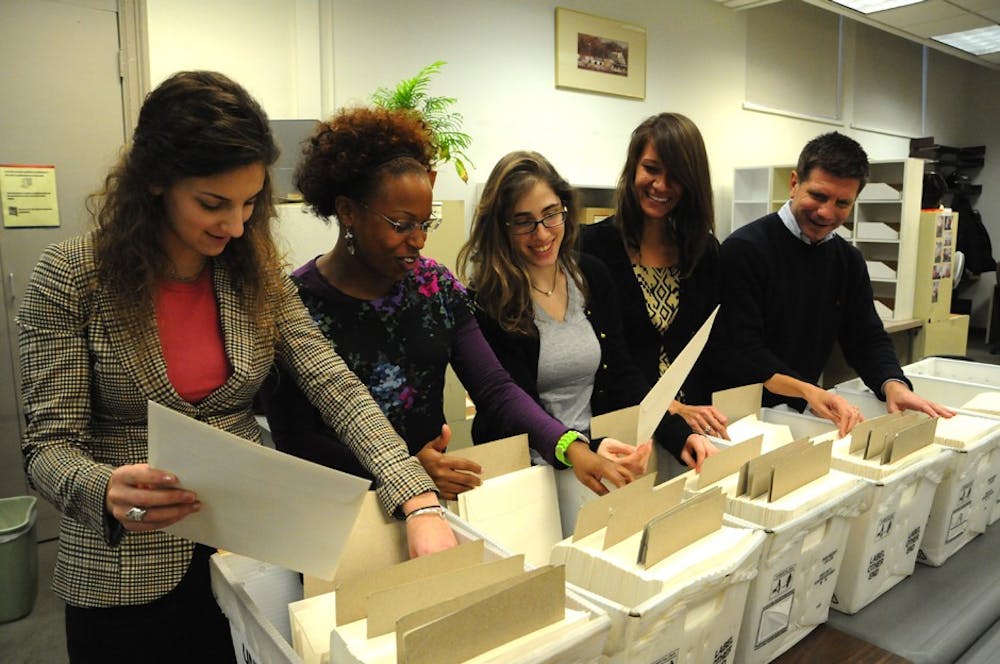
Despite receiving fewer applications than last year, Penn’s early decision acceptance rate declined by almost 1 percent, from 26.1 percent to 25.4 percent this year, Dean of Admissions Eric Furda announced Friday.
Online admissions decisions were available to all applicants at 5 p.m. Friday.
The acceptance rate was “marginally more selective,” Furda said, explaining that 1,148 students were accepted into the Class of 2016 through early decision, a decline from last year’s 1,192.
Penn’s early decision applicant pool dropped from 4,571 last year to 4,526 this year.
This year’s admitted students will comprise approximately 47 percent of the class, according to Furda.
“A good part of this was intentional,” Furda said, explaining that “we’re reserving some spots” for the regular decision cycle. “We want to give ourselves a little more flexibility.”
Furda explained that Princeton and Harvard universities’ early action programs this year “have had an impact” and that he expects some of the students who applied to those schools to apply to Penn in the regular decision round.
“This makes perfect sense,” said Bev Taylor, founder of the Ivy Coach. “Those exceptional students who get deferred from Harvard, Yale, Princeton and Stanford will apply to Penn regular.”
“You do want some wiggle room considering the likely overlap” with these early action schools, agreed Top Colleges Educational Consultant Steven Goodman, who received his master’s degree from the Graduate School of Education in 1989. “I would have done exactly the same thing.”
The number of students who were deferred was in the “low 800s,” a significant decline from last year’s 1,100 deferred students, Furda said.
“We tried to make the tough decisions now,” Furda said. “We hope that we will have a higher admit rate for the deferred students in the regular decision [cycle].”
Deferring fewer students is a “wonderful thing to do,” said Taylor, adding that colleges should not “string kids along and let them hope” if they have no chance of getting in.
For admitted students, the average SAT score increased from 2164 last year to 2172 this year.
While the percentage of underrepresented and international students remained roughly even with last year’s total, the gender ratio of admitted students did change. Forty-seven percent of the admitted class is female, compared to last year’s 52 percent.
“I think by the time we have our [final] class, it’ll end up being 50-50,” Furda said. “But this is interesting.”
Another trend Furda said he noticed was that more students expressed an interest in majoring in fields like architecture and computer science.
For the first time ever, admitted students this year will have access to a class Twitter account, @PreviewingPenn, on which they will be able to interact with each other.
Seeing the acceptance letter on her screen was “the happiest moment of my life,” said Carolyn Rauch, a senior at Millburn High School — located in Millburn, N.J. — who was admitted early to the Class of 2016. “All I saw was the word ‘congratulations’ and I started crying.”
“It’s unbelievable,” agreed her twin brother Ben Rauch, who was also accepted early to Penn, adding that “I’m thrilled we ended up going to school together.”
Ashley Paston — a senior at Jericho High School in Jericho, N.Y. — agreed that she was “very excited” upon receiving her acceptance — though she added that the past few weeks have been “a process filled with anxiety.”
For Joseph Adler — a senior at SAR High School in Riverdale, N.Y., who was deferred early decision to Penn — the process was filled with even more anxiety, since he had to wait an extra day to see his results.
Since the online release time for decisions was moved to 5 p.m. this year from 3 p.m. last year, Adler had to wait until Saturday night to see his decision because he could not use his computer on Shabbat.
“It was incredibly frustrating knowing that the majority of applicants already knew their decisions, and yet I had to wait another 24 hours,” he said.
Adler said he is “definitely still hoping for Penn regular decision,” adding that he believes “the only place that will allow me to excel to my fullest potential would be Penn.”
Columbia University accepted a record low of 19.6 percent of its early decision applicants, according to the Columbia Spectator. Cornell University and Dartmouth College released their decisions last week, but have not yet made numbers available. Brown, Harvard, Princeton and Yale universities will release their decisions this week.
This article has been updated from a prior version to reflect that SAT scores rose over 6 points, not 6 percent.
Related
The Daily Pennsylvanian is an independent, student-run newspaper. Please consider making a donation to support the coverage that shapes the University. Your generosity ensures a future of strong journalism at Penn.
DonatePlease note All comments are eligible for publication in The Daily Pennsylvanian.








